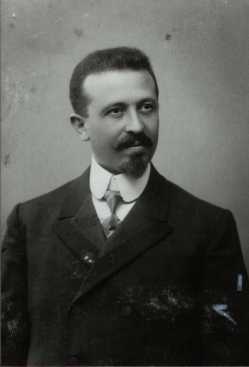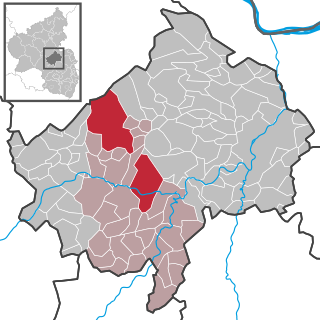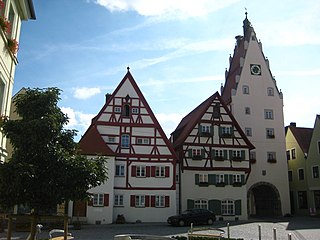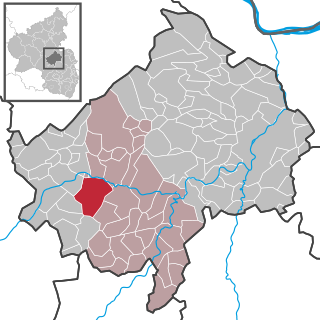
Alzey is a Verband-free town – one belonging to no Verbandsgemeinde – in the Alzey-Worms district in Rhineland-Palatinate, Germany. It is the fifth-largest town in Rhenish Hesse, after Mainz, Worms, Ingelheim am Rhein and Bingen.

Aaron Tänzer was a rabbi in Austria and Germany, chaplain and author.

Bad Sobernheim is a town in the Bad Kreuznach district in Rhineland-Palatinate, Germany. It belongs to the like-named Verbandsgemeinde, and is also its seat. It is a state-recognized spa town, and is well known for two fossil discovery sites and for the naturopath Emanuel Felke. Bad Sobernheim is also a winegrowing town.

Monheim is a town in the Donau-Ries district, in Bavaria, Germany. It is situated 15 km northeast of Donauwörth, and 27 km east of Nördlingen. It lies in the Regierungsbezirk Schwaben.

The Frankfurter Judengasse was the Jewish ghetto of Frankfurt and one of the earliest ghettos in Germany. It existed from 1462 until 1811 and was home to Germany's largest Jewish community in early modern times.

The Jewish courtyard in Speyer, is an historic and archeological site located in the inner city of Speyer, Germany. Built in stages between 1104 and the 14th century, the courtyard contains some of the oldest and best-preserved Jewish community buildings. Along with the other ShUM-cities of Worms and Mainz, Speyer was the hometown of one of the most important Jewish communities in Middle Ages in northern Europe. Because of its historical importance and its testimony to the European Jewish cultural tradition, the Jewish courtyard was inscribed on the UNESCO World Heritage List in 2021.
The history of the Jews in Laupheim began in the first half of the 18th century. Until the second half of the 19th century, the Jewish community in Laupheim, expanded continuously to become the largest of its kind in Württemberg. During this period, the Jewish community gradually assimilated to its Christian surroundings and its members prospered until the beginning of the Nazi-period in 1933. With the deportation of the last remaining Jews in 1942, more than 200 years of Jewish history in Laupheim forcibly came to an end.

Hainsfarth is a municipality in the district of Donau-Ries in Bavaria in Germany.

Argenschwang is an Ortsgemeinde – a municipality belonging to a Verbandsgemeinde, a kind of collective municipality – in the Bad Kreuznach district in Rhineland-Palatinate, Germany. It belongs to the Verbandsgemeinde of Rüdesheim, whose seat is in the municipality of Rüdesheim an der Nahe.

Hennweiler is an Ortsgemeinde – a municipality belonging to a Verbandsgemeinde, a kind of collective municipality – in the Bad Kreuznach district in Rhineland-Palatinate, Germany. It belongs to the Verbandsgemeinde Kirner Land, whose seat is in the town of Kirn.

Hundsbach is an Ortsgemeinde – a municipality belonging to a Verbandsgemeinde, a kind of collective municipality – in the Bad Kreuznach district in Rhineland-Palatinate, Germany. It belongs to the Verbandsgemeinde of Meisenheim, whose seat is in the like-named town.

Merxheim is a small town and Ortsgemeinde in the Bad Kreuznach district in Rhineland-Palatinate, western Germany. It belongs to the Verbandsgemeinde of Bad Sobernheim. The town's economy is traditionally based on wine making. The town is partnered with Merxheim, Haut-Rhin in France. The town is located around 100 km. east of the city of Luxembourg and around 90 km southwest of Frankfurt. Merxheim is located on the border of Moselle Franconian dialects and Hessian dialects.

The history of the Jews in Regensburg, Germany reaches back over 1,000 years. The Jews of Regensburg are part of Bavarian Jewry; Regensburg was the capital of the Upper Palatinate and formerly a free city of the German empire. The great age of the Jewish community in this city is indicated by the tradition that a Jewish colony existed there before the common era; it is undoubtedly the oldest Jewish settlement in Bavaria of which any records exist.

The history of the Jews in Speyer reaches back over 1,000 years. In the Middle Ages, the city of Speyer, Germany, was home to one of the most significant Jewish communities in the Holy Roman Empire. Its significance is attested to by the frequency of the Ashkenazi Jewish surname Shapiro/Shapira and its variants Szpira/Spiro/Speyer. After many ups and downs throughout history, the community was totally wiped out in 1940 during the Holocaust. With the fall of the Iron Curtain in 1989 Jews again settled in Speyer and a first assembly took place in 1996.

The New Synagogue in Ostrów Wielkopolski, Poland, is located in the city's center on 21 Raszkowska Street, which was the northern edge of the former Jewish district. Currently, this is the only preserved metropolitan synagogue. It is built in the once very popular Moorish Revival style. It is the most precious monument of religious architecture in Ostrów Wielkopolski. Long neglected, the synagogue has been fully restored in 2010. See the municipal website for updates:

The history of the Jews in Cologne dates to 321 C.E., when it was recorded in a census decreed by the Emperor Constantine I. As such, it is the oldest European Jewish community north of the Alps. The community quickly established itself in what came to be known as Cologne's Jewish quarter, building its first synagogue by 1040 C.E. The Crusades put an end to peaceful coexistence with Christians in 1096 C.E. Despite the Archbishop's protection many Jews were killed and their synagogue destroyed. The community regained its economic and religious life until about 1300 C.E., when the Christian majority again applied pressure. The community's fortunes improved and worsened a number of times into the 20th century. Before the 1930s, it consisted of 19,500 people. After the end of World War II it had been almost entirely extinguished due to Nazi destruction, expulsion and murder. Currently it numbers approximately 5,000.
The history of the Jews in Königsberg reaches back to the 1530s. By the 20th century Königsberg had one of the larger Jewish communities within the German Reich. The city's Jewish community was eliminated by emigration and then The Holocaust during World War II.

The Synagoge Zürich Löwenstrasse is the oldest and largest synagogue in the Swiss municipality of Zürich. In 1884 built in Moorish style, the oldest synagogue of Zürich also houses the prayer and school house of Israelitische Cultusgemeinde Zürich (ICZ) which was founded in 1862. ICZ is a unified Jewish community having about 2,500 members, and thus the largest Jewish community in Switzerland, which since 2007 in the Canton of Zürich is recognized as a denomination, i.e. it has the same legal state as the Christian denominations. In the synagogue, the community celebrates the daily Minyan and Shabbat and holiday services. The synagogue is a cultural heritage of national importance in Switzerland.

The History of the Jews in Freiburg dates back to the Late Middle Ages when, at the site of today's Wasserstraße and Weberstraße, there was reference to a ghetto. In 1328, a synagogue was located at 6 Weberstraße.
The history of the Jews in Hannover began in the 13th century. In 2009, about 6200 people belonged to the four Jewish communities in Hannover.
























